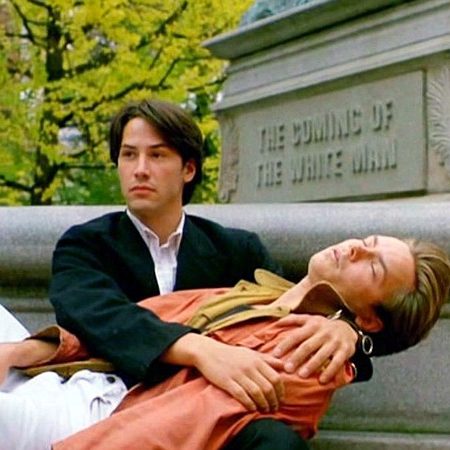
It begins with what look like scenes filmed inside a snow globe, an apt metaphor for the films of husband-wife team Dominique Abel and Fiona Gordon. The couple (Gordon is Australian) write and direct comedies based on equal parts Tati and Wes Anderson (Rumba), in which bold primary colors and self-conscious framing remind audiences that the so-called real world awaits any filmmakers willing to bend it to their will. Lost in Paris is notable for being the last film of New Wave icon Emmanuelle Riva, best known to American audiences for Alain Resnais’ chic ontological shadowplay Hiroshima Mon Amour and to play the Alzheimer’s-ravaged wife in Michael Haneke’s 2012 Amour. Rather too delighted with itself, Lost in Paris is rare case of a take-or-leave-it experience; you’ll either respond to Abel and Gordon’s whimsy or you won’t.
Anchoring the film is Gordon, who has a goofball Olive Oyl presence and posture. In a lime green dress, hair in bun, and blood red travel bag, she’s a walking target. Fiona (Gordon) has wanted to follow her aunt Martha (Riva) to Paris since the latter left their sleepy snow-covered Canadian town. Awkward, speaking little French, Fiona is the living embodiment of the perils of North Americans unleashed in a city whose residents pretend not to seek English, or the perils of North Americans without sea legs — literally in this case. Taking a photo of the Eiffel Tower as backdrop she tumbles, to the accompaniment of a banjo, into the Seine, her backpack like a turtle’s shell until it comes loose. Now she’s drenched and broke. Worse, when she gets to Aunt Martha’s apartment, she learns that the increasingly senile woman has disappeared. Meanwhile, a vagrant named Dom (Abel) finds the backpack. Typical of the film’s humor is the nonchalant manner in which he helps himself to Fiona’s clothes; he looks especially fetching in a yellow sweater. He treats himself to a dinner at a fine restaurant, albeit in a corner table by the kitchen door for the purpose of Mr. Bean-esque routines as waiters shove past him. Dom and Fiona eventually meet on a restaurant-boat, but the writer-directors don’t have Cary Grant and Audrey Hepburn in mind.
Lost in Paris is not unusual in using plot as a clothesline on which to hang the scenarists’ most fanciful ideas. Sight gags abound. I liked one involving a deejay’s blasting the Gotan Project on that same boat: patrons jump in their seats to the rhythm of the music. An amiable Canadian mountie in uniform emerges as Dom’s romantic rival, and Martha, who may not be dead after all, herself emerges as a romantic rival to Fiona. Nothing is at stake in Lost in Paris. It’s a summer idyll, a vacation in which you don’t mind the tourist trap cuisine or the sense in which you’re conscripted into having a good time.
GRADE: B-
